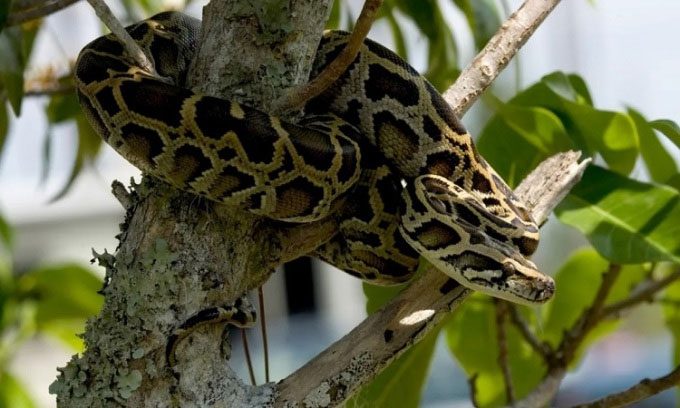Researchers have discovered that the hybrids of Burmese pythons and Indian pythons have a better adaptability to the environment, allowing them to spread more rapidly.
Inter-species hybridization is creating a challenging issue in the conflict with invasive pythons in Florida. A few years ago, scientists found a large number of gigantic pythons lurking in the Everglades swamp, which were hybrids resulting from the mating of two different species: Burmese python (Python bivittatus) and Indian python (P. molurus). Notably, the hybrids seem to adapt better to the new environment than their parent species, as reported by IFL Science on October 21.

Burmese python hanging on a tree trunk in Everglades National Park. (Photo: R. Cammauf).
As their names suggest, the Burmese python and the Indian python are native to the tropical rainforests of Asia, not the Florida swamps. Researchers believe they were introduced to the state in the 1970s, likely through the exotic pet trade. The population exploded in August 1992 when Hurricane Andrew destroyed a python breeding facility near the Everglades, releasing a large number of pythons into the wild.
The new swamp environment was suitable for these pythons. The gigantic snakes quickly established a breeding population, competing with native animals due to their voracious appetite and hunting skills. Since the python population explosion a few decades ago, the numbers of small mammals such as marsh rabbits, cotton-tailed rabbits, and foxes have nearly disappeared from the Everglades. A 2012 study found that the population of panthers in the Everglades decreased by 99.3%, opossums by 98.9%, and bobcats by 87.5% since 1997.
Efforts to combat the invasive pythons have made little progress, but scientists continue to closely monitor the python population in search of solutions. In 2018, a research team from the U.S. Geological Survey (USGS) conducted genetic analysis on about 400 Burmese pythons captured across a vast area of South Florida. The study published in the journal Ecology and Evolution revealed at least 13 hybrids between Burmese pythons and Indian pythons genetically, confirming they are products of inter-species hybridization.
“Pythons in South Florida can be identified as Burmese pythons based on their appearance, but genetically, that’s a more complex story,” said Margaret Hunter, a geneticist at USGS and lead researcher.
Typically, when two similar species hybridize, the offspring often face disadvantages. They may be infertile or encounter numerous challenges that make them less suited to their environment. However, sometimes, the right combination can produce hybrids that outperform their non-hybrid counterparts, known as hybrid vigor.
“Hybridization can lead to hybrid vigor, meaning the best traits of both species are passed on to their offspring. Hybrid vigor may lead to better adaptability to environmental pressures and changes. In invasive populations like the Burmese pythons in South Florida, this could result in a wider distribution or faster spread,” Hunter explained.
Meanwhile, the battle against invasive pythons continues. One reason the python population is so difficult to control is their exceptional ability to camouflage in their habitat. Genetic techniques may provide scientists with new tools to better understand the threat. “By using genetic tools and techniques to continue monitoring the movement patterns of invasive pythons, we can gain a better understanding of their preferred habitats and resource usage,” said ecologist Kristen Hart at USGS, co-author of the study.


















































